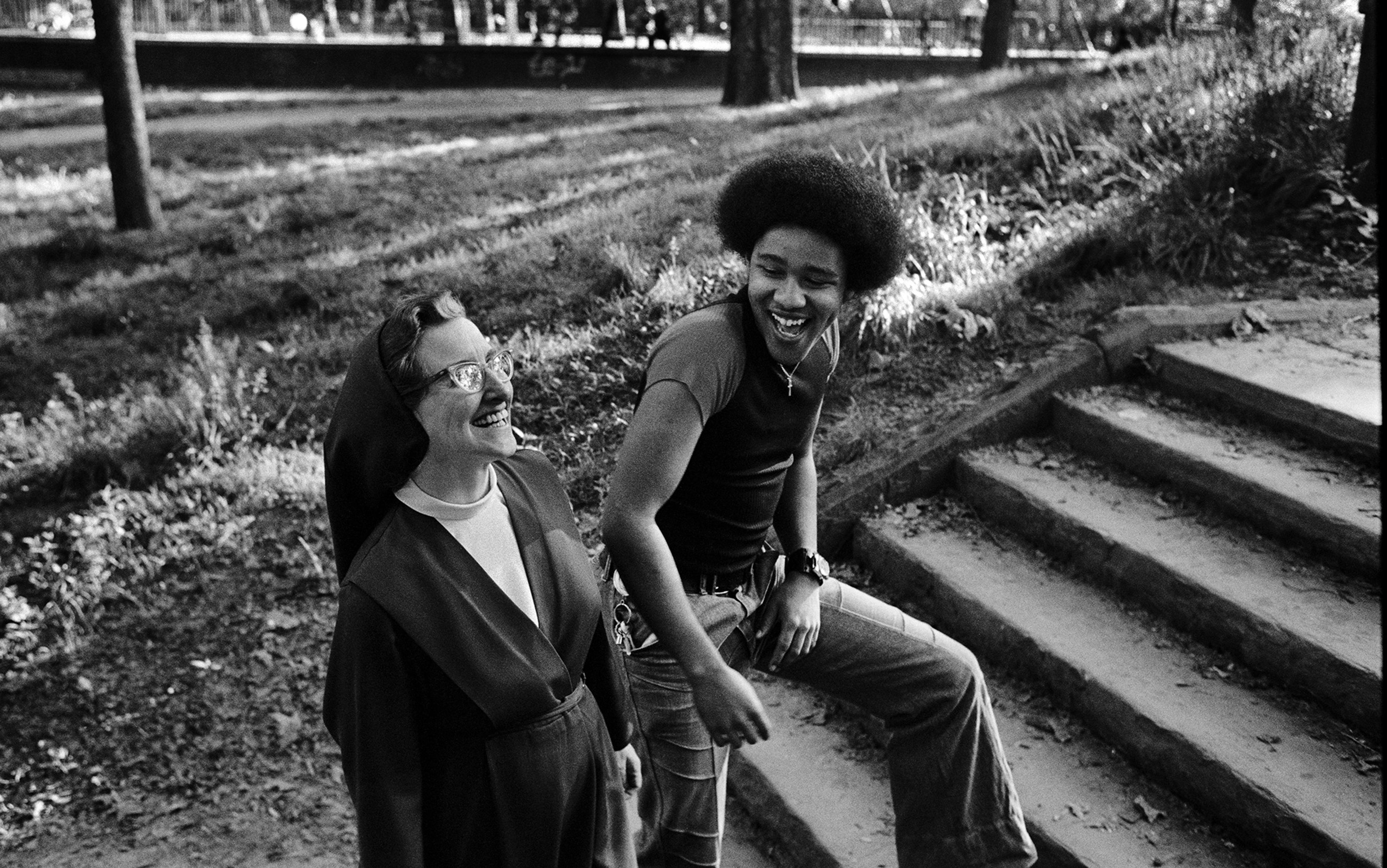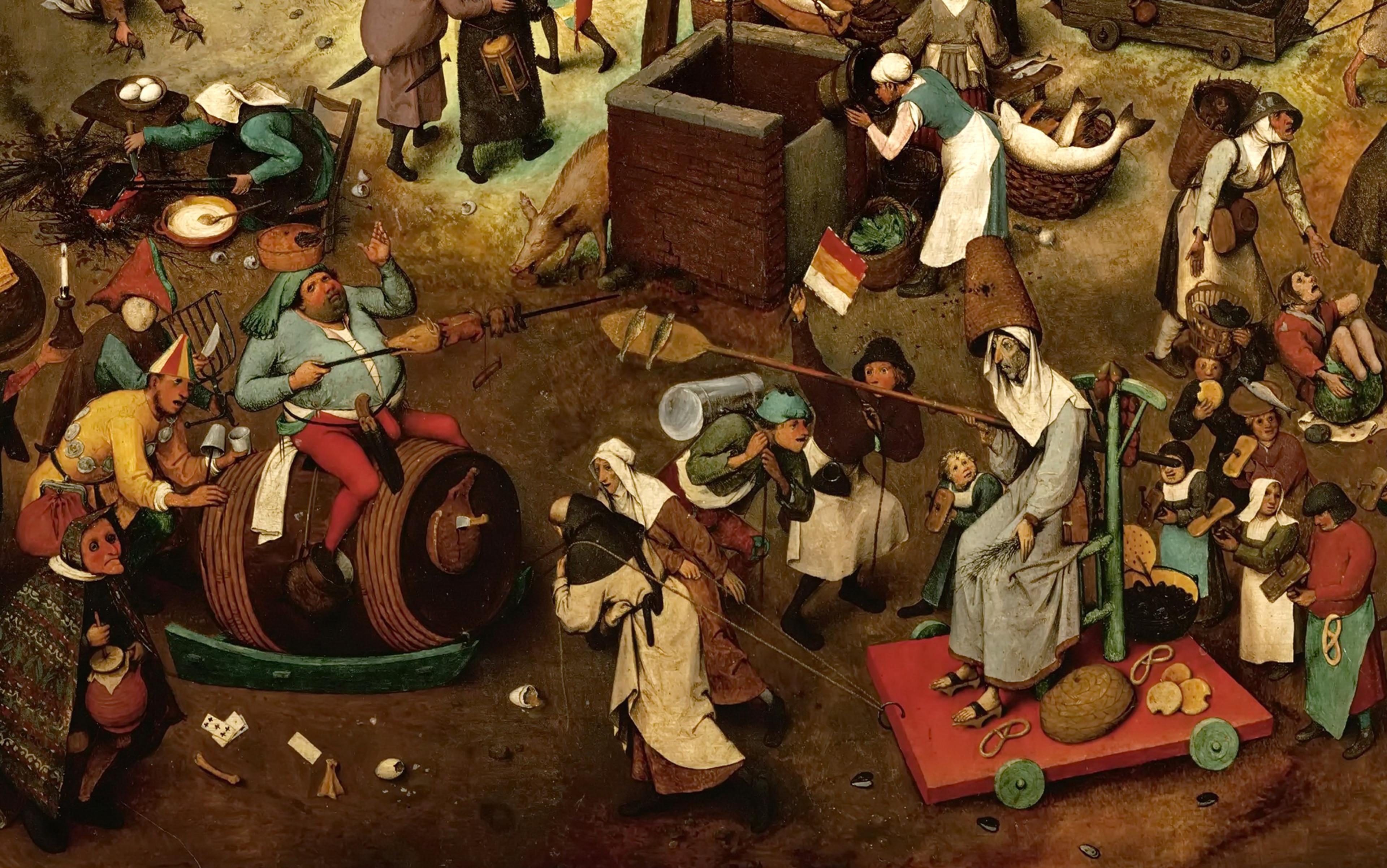In a Monty Python sketch from 1970, a cheesy game show host (John Cleese) asks an ill-tempered, racist, uncooperative old lady contestant (Terry Jones) a ludicrously challenging question. The exchange unfolds as follows:
Cleese: What great opponent of Cartesian dualism resists the reduction of psychological phenomena to physical states?
Jones: I don’t know that!
Cleese: Well, have a guess.
Jones: Henri Bergson.
Cleese: Is the correct answer!
Jones: Ooh, that was lucky. I never even heard of him!
The Pythons were well-versed in the history of philosophy (and in the drinking habits of Western philosophers). It therefore didn’t escape them that this particular French philosopher was also the author of a popular essay that focused on a phenomenon all comedians take very seriously: laughter.
Before Bergson, few philosophers had given laughter much thought. The pre-Socratic thinker Democritus was nicknamed the ‘laughing philosopher’ for espousing cheerfulness as a way of life. However, we know more about his thoughts on atomism than on laughter. Similarly, the section of Aristotle’s Poetics that dealt with comedy hasn’t come down to us. Other major thinkers who have offered passing, often humourless, reflections about humour include Thomas Hobbes and René Descartes, who believed that we laugh because we feel superior; Immanuel Kant and Arthur Schopenhauer who argued that comedy stems from a sense of incongruity; and Herbert Spencer and Sigmund Freud who suggested that comedians provide a form of much-needed relief (from, respectively, ‘nervous energy’ and repressed emotions). Bergson was unconvinced by these accounts. He believed that the problem of laughter deserved more than a few well-worded digressions. Although his theory retained elements of the incongruity and superiority theories of humour, it also opened entirely new perspectives on the problem.
The Monty Pythons could safely assume that Bergson’s name would come across as particularly obscure to an anglophone audience – the sketch plays on the incongruity of the old lady plucking this unfamiliar name from the air. However, when Bergson’s Laughter: An Essay on the Meaning of the Comic (1900) was published, his philosophy was discussed in most intellectual circles and, a few years later, he would become one of the most famous thinkers in the world. Why did a philosopher of such renown deviate from his more traditional and serious philosophical obsessions – the nature of time, memory, perception, free will and the mind-body problem – to focus on the apparently frivolous case-studies of slapstick, vaudeville and word play? And what was there to be gained from such analysis? The topic was a ticklish one. Laughter, wrote Bergson, had ‘a knack of baffling every effort, of slipping away and escaping only to bob up again, a pert challenge flung at philosophic speculation’. It was almost as though there was something unnatural about subjecting one of the most pleasurable and ubiquitous human experiences to dry philosophical speculation. Anyone who has ever had to explain their own joke knows that comedy cannot survive that sort of analysis. As the American authors E B White and Katharine S White put it in 1941:
Humour can be dissected, as a frog can, but the thing dies in the process and the innards are discouraging to any but the purely scientific mind.
While his book on laughter is hardly a rib-tickling read, Bergson didn’t wish to adopt the attitude of an anatomist observing a frog’s dead insides. He believed that laughter should be studied as ‘a living thing’ and treated ‘with the respect due to life’. His investigation was therefore more like that of a field zoologist observing frogs in the wild:
we shall not aim at imprisoning the comic spirit within a definition … We shall confine ourselves to watching it grow and expand.
Like all good metaphorical field zoologists, Bergson started his study by familiarising himself with his metaphorical frog’s natural habitat: in other words, the conditions under which laughter is most likely to appear and thrive. Following this method, Bergson arrived at three general observations.
The first one, according to Bergson, was so ‘important’ and ‘simple’ that he was surprised it hadn’t attracted more attention from philosophers: ‘The comic does not exist outside the pale of what is strictly human.’ When Bergson wrote these words, he couldn’t have foreseen that, a century later, through the power of the internet, one of the most popular forms of comedy would be provided by our own pets in the form of viral videos, memes and gifs. But, in a way, he anticipated it in what he wrote about laughter directed at non-humans:
You may laugh at an animal, but only because you have detected in it some human attitude or expression.
Consider for instance the viral sensation of Grumpy Cat (now sadly deceased). Her perpetual scowl makes us laugh because it is relatably human. The essence of her comedy lies in the fact that she is a humanlike cat. The same goes for inanimate objects that make us laugh. The American vaudeville performer Will Rogers once quipped: ‘An onion can make people cry but there’s never been a vegetable that can make people laugh.’ Enter the internet with its millions of more-or-less safe for work anthropomorphic vegetable content to prove him wrong. According to Bergson, it is possible to laugh at vegetables and nonsentient things, but only on the condition that we are able to detect the human in them:
You may laugh at a hat, but what you are making fun of, in this case, is not the piece of felt or straw, but the shape that men have given it, – the human caprice whose mould it has assumed.
Bergson’s second observation might appear counterintuitive to anyone who has been reduced to tears by a fit of uncontrollable giggles: ‘Laughter has no greater foe than emotion.’ But his point was that certain emotional states – pity, melancholy, rage, fear, etc – make it difficult for us to find the humour in things we might otherwise have laughed at (even anthropomorphic vegetables). We instinctively know that there are situations in which it is best to refrain from laughing. Those who choose to ignore these unspoken rules are immediately sanctioned, as the American comedian Gilbert Gottfried learned the hard way. While most major US late-night comedy shows halted production in the weeks following the terrorist attacks of 11 September 2001, Gottfried provided a textbook case of a joke being ‘too soon’ during a comedy roast that took place before the month had ended:
I have to leave early tonight, I have a flight to California. I can’t get a direct flight – they said I have to stop at the Empire State Building first.
The comedian later recalled: ‘I don’t think anyone’s lost an audience bigger than I did at that point.’ Bergson would say that the emotional stakes were too high to allow for the ‘momentary anaesthesia of the heart’ that laughter demands. For laughter to occur, we must shift our perspective such that we find ourselves in the position of a ‘disinterested spectator’.
‘Why are obtuse angles so depressed? Because they’re never right’
This is not to say that it’s impossible to laugh in times of hardship. In many cases, humour appears to serve as a coping mechanism in the face of tragedy or misfortune. In 1999, as he was being carried out of his house on a stretcher after a crazed fan stabbed him, the former Beatle George Harrison asked a newly hired employee: ‘So what do you think of the job so far?’ On his death bed, Voltaire allegedly told a priest who was exhorting him to renounce Satan: ‘This is no time for making new enemies.’ Following Bergson’s logic, perhaps in some cases humour is cathartic precisely because it forces us to look at things from a detached perspective.
Finally, laughter ‘appears to stand in need of an echo’, according to Bergson. Evolutionary theorists have hypothesised about the adaptive value of laughter, in particular in the context of social bonding. Laughter might have emerged as a prelinguistic signal of safety or belonging within a group. Laughter and humour continue to play an important role in our various social groups. Most countries, regions and cities share a wide repertoire of jokes at the expense of their neighbours. For example, this Belgian dig at my compatriots, the French: ‘After God created France, he thought it was the most beautiful country in the world. People were going to get jealous, so to make things fair he decided to create the French.’
Jokes need not be nationalistic or even derogatory in nature to facilitate social bonding. Most friends share ‘in-jokes’ that are meant to be understood only within the context of their particular social group, as do certain communities brought together by a football team, political opinions or shared specialist knowledge (‘Why are obtuse angles so depressed? Because they’re never right’). Our laughter ‘is always the laughter of a group’, as Bergson put it. Even in those cases when we are effectively laughing alone, to, or perhaps at ourselves, laughter always presupposes an imagined audience or community.
Bergson’s observations tell us where to find laughter, under which conditions it is possible for laughter to emerge, but they don’t tell us why we laugh. They do nonetheless provide us with important clues. It is no accident that we laugh exclusively at other humans, and that laughter is a communal experience: its purpose, or ‘function’, wrote Bergson, is social. In addition, it isn’t by chance that laughter requires a temporary shutdown of our emotions: though pleasurable, laughter is above all punitive. But what, or whom, is laughter punishing, and how does it do that? To understand Bergson’s reasoning, we need to make a rapid detour to examine his philosophy of life.
Less than a decade after Laughter was published, Bergson had moved on to one of the pressing issues of the day: biological evolution. In his surprise bestseller Creative Evolution (1907), Bergson describes life as an ever-changing, creative (ie, producing entirely new and unpredictable forms) and spontaneous movement. In this sense, life exhibits the opposite of the mechanical tendencies of inert matter characterised by rigidity, predictability and repetitiveness. At the same time, life and matter are inexorably intertwined. Using metaphorical language, Bergson describes life as an ‘effort’, a ‘vital impetus’ constantly striving to break free from its own material constraints through ever more sophisticated evolutionary innovations. However, said Bergson, ‘most often this effort turns short’. Throughout the history of life, organisms that have failed to adapt to environmental challenges have gone extinct. Both at the individual and at the species level, survival has depended on organisms’ ability to demonstrate ‘a certain elasticity’, enough adaptability to find ways around material obstacles.
These questions were already on Bergson’s mind when he was writing Laughter. He envisioned the comical, and the laughter it provokes, as a sophisticated solution to a particularly human problem. As a product of biological evolution, human societies were also concerned with the struggle between vital and material (or mechanistic) tendencies. Social life, wrote Bergson, requires a ‘delicate adjustment of wills’ and constant ‘reciprocal adaptation’ between the members of the group. Society therefore needs its members to display ‘the greatest possible degree of elasticity and sociability’, and needs to guard itself against ‘a certain rigidity of body, mind and character’. These ossified expressions of human life are, according to Bergson, at the source of the comical, because this is precisely what laughter seeks to correct. Rather than a definition of the comical, Bergson arrived at a ‘leitmotiv’, a common thread uniting various forms of comedy: in general, we laugh at ‘something mechanical encrusted on the living’. A few examples will help illuminate this point.
A man is walking down the street, he slips and falls. Hilarity ensues. Why are benign blunders of this nature almost always funny? According to Bergson, it is the involuntary nature of the action that makes us laugh. Stumbles, gaffes, slipups, bloopers and general clumsiness indicate both a lack of versatility and of awareness: ‘where one would expect to find the wideawake adaptability and the living pliableness of a human being’, we find instead ‘a certain mechanical inelasticity’.
Consider a scene from the classic film Modern Times (1936) in which Charlie Chaplin plays a factory worker subjected to the relentless cadence of an assembly line. Even outside the factory, he continues to erratically tighten imaginary bolts, stuck in the repetitive movement he has been executing all day. In Bergsonian terms, this is funny because we are seeing someone act out deeply engrained habits even though the circumstances demand otherwise. Both in the case of accidental blunders and in carefully choreographed slapstick comedy, we are laughing at figures who lack ‘elasticity’, who are mechanically following a predetermined trajectory and therefore fail to adapt to their surroundings.
This explains why so many action films rely on the trope of the ‘oblivious bystander’ for comic relief: a character (usually wearing headphones) is completely unaware of the incredible event happening just outside their eyeshot: recent examples include a waitress oblivious to a wizarding duel taking place in her café in Harry Potter and the Deathly Hallows: Part 1 (2010) and an office worker who fails to notice a man attempting to scale a building outside her window in Mission: Impossible – Fallout (2018). Another recurring figure is the absentminded professor: a character so engrossed in his own thoughts that he forgets to pay attention to his surroundings – for instance, the astronomer in Aesop’s fable who fell into a well while gazing at the night sky, or the eccentric Doc Emmett Brown in the Back to the Future franchise (1985-90). From Aesop to Chaplin (and beyond), characters who lack awareness, both of their surroundings and of themselves, are staples of comedy because they capture what laughter seeks to correct: deficiencies of the ‘elasticity of mind and body’ that ‘enable us to adapt’ to our immediate situation.
Critics gushed that she had reinvented comedy yet one of the funniest scenes of Fleabag is a fart joke
In an iconic scene from the Marx Brothers’ comedy Duck Soup (1933), we see two characters (played by Harpo and Groucho Marx) dressed identically, positioned either side of a missing mirror. To trick Groucho into thinking that he is looking at his own reflection, Harpo copies his every move. According to Bergson, laughter targets cases in which life appears to have lost its vitality and adopts instead the logic of matter and machines. For instance, according to Bergson, in nature, life never truly repeats itself. There will never be two truly identical living beings (even twins don’t share the exact same experiences). Therefore, ‘wherever there is repetition or complete similarity, we always suspect some mechanism’, he writes, and when this repetition takes, in one way or another, a human form, we are (potentially) in the presence of the comical. Both fortuitous resemblance (for instance, the uncanny likeness between the actor Adam Driver and yet another internet cat) and skilful impersonation are funny because they remind us of mechanically produced copies. It is, writes Bergson, ‘this deflection of life towards the mechanical’ that ‘is here the real cause of laughter’.

Photo courtesy Monmouth County SPCA/Afp/Getty
When the English actor, writer and producer Phoebe Waller-Bridge blessed our television screens with a second season of Fleabag in 2019, critics gushed that she had reinvented comedy (notably by introducing a new kind of ‘meta’ fourth-wall breaking). Yet it remains that one of the funniest scenes of the season is a fart joke. According to Bergson, it is not surprising that a lot of comedic devices focus on the body (and bodily functions). The comedic value of body-centred humour (such as toilet humour and sexual innuendo) lies in the fact, said Bergson, that ‘our attention is suddenly recalled from the soul to the body’. The irruption of a bodily function (Bergson imagines a ‘public speaker who sneezes just at the most pathetic moment of his speech’) or a risqué double entendre, focuses our attention on our own material limitations. The body appears as ‘a heavy and cumbersome vesture … which holds down to earth a soul eager to rise aloft’.
Interestingly, Bergson considers that the same kind of logic applies to wordplay. Much word-based humour consists in taking literally words and phrases we would normally use figuratively (‘I have the heart of a lion, and a lifetime ban from the Toronto zoo’). By subverting the meaning and common usage of words, these jokes reveal what is ‘ready-made’, habitual, and therefore mechanical, about language. In other words, puns and witticisms expose the material limits and the mechanical rigidity of language. Both in the case of the human body and the ‘body’ of language, the rigidity that’s suggested is at odds with the flexibility, malleability and adaptability that life, and especially social life, require of us.
In a rare moment of perspicacity, the male supermodel Derek Zoolander (portrayed by Ben Stiller in the eponymous 2001 comedy) reflects: ‘Did you ever think that maybe there’s more to life than being really, really, really ridiculously good looking?’ For Bergson, vanity is one of the most laughable traits. In the same way that a lack of awareness of one’s material surroundings can result in (often comical) physical injuries, an unhealthy obsession with oneself denotes a lack of awareness of others, which can in turn damage society. This damage is subtle and therefore, he writes, requires a subtle antidote:
vanity, though it is a natural product of social life, is an inconvenience to society, just as certain slight poisons, continually secreted by the human organism, would destroy it in the long run if they were not neutralised by other secretions. Laughter is unceasingly doing work of this kind.
In other words, according to Bergson, laughter serves a social function: its purpose is to gently but firmly correct these socially ‘inconvenient’ attitudes. We laugh at people who are either too eccentric or too inflexible to allow for society to evolve and better itself. It is in this sense that laughter is punitive:
society holds suspended over each individual member, if not the threat of correction, at all events the prospect of a snubbing, which although it is slight, is none the less dreaded. Such must be the function of laughter.
But for Bergson, laughter doesn’t exclusively punish attitudes that we deem reprehensible. Homer Simpson’s morally irreproachable neighbour Ned Flanders is proof that even virtue can be ridiculous when portrayed as a form of mental rigidity. Laughter awakens us to the inelasticity of certain personality traits or behaviours and, in doing so, dissuades us from becoming too settled in our own ways.
Bergson’s critics have complained that his theory of humour is too restrictive, that his repetitive characterisation of the comedic as ‘something mechanical encrusted upon the living’ becomes laughable in its own terms, trying to fit a complex and spontaneous living phenomenon under the same rigid formula. But Bergson claimed that, rather than a clear-cut definition, this formula was a ‘leitmotiv’: representations of mechanised life constitute a common thread in many different forms of comedy. His theory didn’t preclude that we might laugh at things that are not obviously mechanical, nor that the mechanical might not be the only source of laughter. What mattered to Bergson was to understand laughter as a product and a part of life.
By giving comedy the attention it deserved, Bergson opened new perspectives on difficult philosophical questions about the relationship between biology and art, the evolution of human societies, and our own humanity. The philosopher recognised that laughter doesn’t always bring out the best in us – it can be used to mock and degrade others. But at its core, its function is to remind us that to be human is to be alive and free. Bergson’s book on laughter therefore raised the status of a problem that has often been deemed unworthy of serious philosophical study. In Monty Python’s Flying Circus (2008), the film scholar Darl Larsen writes that Bergson’s theory ‘seems to have been an influential work on the Pythons’ because, by proposing a theory of laughter, ‘the respected Bergson elevated the study of comedy to a more academic level, worthy of study in works looking at aesthetics and philosophies of art forms’. In another sketch, Cleese (playing a reporter) is caught on air mid-conversation explaining that he adheres ‘to the Bergsonian idea of laughter as a social sanction against inflexible behaviour’. This was perhaps the Pythons’ way of paying homage to Bergson: despite all its silliness, they too believed that comedy should be taken dead seriously.
If you enjoyed this Essay, Emily Herring went on to have success with her book Herald of a Restless World: How Henri Bergson Brought Philosophy to the People (2024). Of the connection between her book and this Essay, Emily said: ‘Writing for Aeon offered me a space to shape and refine my ideas while being held to a high standard of clarity. This gave me confidence and focus when putting together my book proposal and carried through into writing the book itself. The chapter on laughter in Herald of a Restless World (2024) is drawn almost entirely from my Aeon essay, and it set the tone for the other chapters, which I tried to approach with the same depth and precision, without sacrificing readability.’ You can also read more from Emily Herring on Aeon here.






